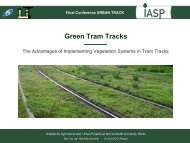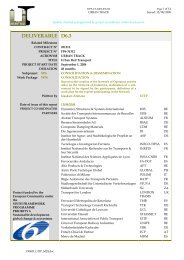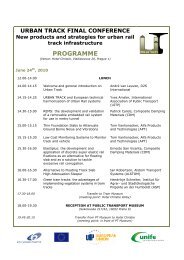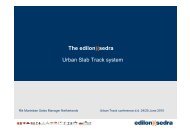DELIVERABLE 2.8 - urban track
DELIVERABLE 2.8 - urban track
DELIVERABLE 2.8 - urban track
You also want an ePaper? Increase the reach of your titles
YUMPU automatically turns print PDFs into web optimized ePapers that Google loves.
2.3. BREMEN (BSAG)<br />
D0208_STIB_M24.doc<br />
TIP5-CT-2006-031312 Page 13 of 44<br />
URBAN TRACK Issued: August 13, 2008<br />
Quality checked and approved by project co-ordinator André Van Leuven<br />
The practice at BSAG is similar to Brussels with the exception that they do not perform the pre-emptive<br />
build-up welding. BSAG installs the rail as is and welds in the field when necessary. Until about 20<br />
years ago, BSAG also did pre-emptive build-up welding before bending the rails. This gave problems<br />
during the bending as the two different metals (bimetal) behaved differently and caused the weld to split<br />
off from the rail. The welding is now performed by an outside contractor in which BSAG owns 51%. The<br />
60% of paved <strong>track</strong> is Ri59 and previously Ri60, all of Q700. The 40% open <strong>track</strong> is 49E1 (earlier S49) of<br />
Q900 and before S41 of Q700.<br />
Another difference is the <strong>track</strong> design, which prevents wheel from touching the lip of the rail. The lip<br />
cannot be used for guidance. That means that BSAG only has (lateral) wear on the railhead. The<br />
introduction of the new low floor trams in 1996 has changed the wear pattern. Before there was only<br />
wear on the outer rail in curves with a radius below 40 m. Now the wear is distributed with 1/3 on the<br />
outer rail and 2/3 on the inner rail. On new rails, the inner rail needs treatment first. This is also due to<br />
the selection of the rail: NP4am (and also Ri60) has a groove of 34 mm, whereas Ri59 has a groove of<br />
42 mm. The extra 8 mm make that there is less contact with the flange. BSAG designs its <strong>track</strong>s to avoid<br />
flange wear on the back of the wheel. BSAG used to remove up to 9 mm lateral and 7 mm vertical. This<br />
caused problems when welding again. When the rail wears in the vertical direction, the weld may split<br />
off.<br />
BSAG was also experimenting with Q900 rail to avoid welding. Now Q700 grooved rail is used; they still<br />
see normal wear on the railhead with lateral wear of 6 mm after 12 to 18 months before re-welding. The<br />
next re-welding then takes place when the wear is 7 mm, i.e. when it is more than the layer added in the<br />
previous re-welding process. In the next step a wear of then e.g. 8 mm is allowed, then 9 mm etc where<br />
BSAG allows a maximum gauge widening of 20 mm.<br />
BSAG also introduced wheel flange lubrication. The second welding now takes place after 2 to 3 years<br />
with a material of the same quality as Q900. It is normal practice to do the build-up welding 8 times,<br />
using the same material as Brussels. Rail life this way can be extended to about 15 to even 20 years.<br />
The main advantage of not welding pre-emptively is the cost of machining the rail.<br />
Since 1996 all vehicles are equipped with wheel lubrication which has generated a reduction in welding<br />
costs of 15% with the added benefit that squeal is eliminated.








